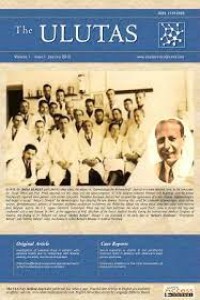Acute Nonsuppurative Sialadenitis After Contrast Material Administration For Computed Tomography Angiography
Abstract
Introduction: By the use of iodine-containing intravenous contrast agents, sialadenitis rarely occurs with a sudden expansion of the salivary glands. Its pathogenesis is uncertain, but it appears to be the result of an idiosyncratic reaction or accumulation of iodine in the ductal system of the salivary gland. In this article, we aimed to present a case of contrast-induced sialadenitis after an iodine-containing contrast agent.
Case Presentation: A sixty-six-year-old male with a history of abdominal aortic aneurysm was referred for CT angiography. The patient had referred to emergency service with mildly tenderness, pain, and swelling in the bilateral submandibular region. Physical examination also revealed mildly enlarged bilateral submandibular glands, with no fever. There was no erythema, ulcer, and no symptom in both oral and oropharyngeal mucosa. The US performed bilateral diffuse homogeneous expansion of the submandibular salivary glands. In the light of clinical and radiological findings, contrast-induced non-suppurative sialadenitis was considered.
Conclusion: Non-suppurative sialadenitis is a rare adverse effect of contrast material administration, which true incidence is unknown. Chronic kidney failure and repeated dose of contrast material are risk factors for this complication. We think that this adverse effect deserves more attention, and follow-up, and prevention for recurrence because its long-term importance is unknown yet.
References
- 1. Lucarelli A, Perandini S, Borsato A, Strazimiri E, Montemezzi S. Iodinated contrast-induced sialadenitis: a review of the literature and sonographic findings in a clinical case. J Ultrason 2018;18:359-64
- 2.Mihn A, Suan D. Iodide mumps. Clin Imaging 2001;37:367-8
- 3. Katayama H, Yamaguchi K, Kozuka T, Takachima T, Seez P, Matsuura K. Adverse reaction to ionic and nonionic contrast media: a report from the Japanese Committee on the Safety of Contrast Media Radiology 1990; 175: 621-8
- 4. Thomsen HS. European Society of Urogenital Radiology ( ESUR ) guidelines on the safe use of iodinated contrast media. 2006;60:307-13
- 5. Bohora S, Harikrishnan S, Tharakan J. Iodide mumps. Int J Cardiol 2008;130:82-3
- 6. Erdoğan D, Güllü H, Çalışkan M, Ulus T, Müderrisoğlu H. Nonionic contrast media induced sialadenitis following coronary angiography. Anatol J Cardiol 2006;6:270-1
- 7.McCullough M, Davies P, RicHardson R. A large trial of intravenous Conray 325 and Niopam 300 to assess immediate and delayed reactions Br J Radiol 1989;62:260-5
- 8.Cohen JC, Roxe D. M, Said R, Cummings G. Iodide mumps after repeated exposure to iodinated contrast media. Lancet 1980;1:762-3
- 9.Christensen J. Iodide mumps after intravascular administration of a nonionic contrast medium. Case report
Abstract
References
- 1. Lucarelli A, Perandini S, Borsato A, Strazimiri E, Montemezzi S. Iodinated contrast-induced sialadenitis: a review of the literature and sonographic findings in a clinical case. J Ultrason 2018;18:359-64
- 2.Mihn A, Suan D. Iodide mumps. Clin Imaging 2001;37:367-8
- 3. Katayama H, Yamaguchi K, Kozuka T, Takachima T, Seez P, Matsuura K. Adverse reaction to ionic and nonionic contrast media: a report from the Japanese Committee on the Safety of Contrast Media Radiology 1990; 175: 621-8
- 4. Thomsen HS. European Society of Urogenital Radiology ( ESUR ) guidelines on the safe use of iodinated contrast media. 2006;60:307-13
- 5. Bohora S, Harikrishnan S, Tharakan J. Iodide mumps. Int J Cardiol 2008;130:82-3
- 6. Erdoğan D, Güllü H, Çalışkan M, Ulus T, Müderrisoğlu H. Nonionic contrast media induced sialadenitis following coronary angiography. Anatol J Cardiol 2006;6:270-1
- 7.McCullough M, Davies P, RicHardson R. A large trial of intravenous Conray 325 and Niopam 300 to assess immediate and delayed reactions Br J Radiol 1989;62:260-5
- 8.Cohen JC, Roxe D. M, Said R, Cummings G. Iodide mumps after repeated exposure to iodinated contrast media. Lancet 1980;1:762-3
- 9.Christensen J. Iodide mumps after intravascular administration of a nonionic contrast medium. Case report
Details
| Primary Language | English |
|---|---|
| Subjects | Health Care Administration |
| Journal Section | Case Report |
| Authors | |
| Publication Date | June 25, 2020 |
| Submission Date | March 2, 2001 |
| Published in Issue | Year 2021 Volume: 7 Issue: 2 |


